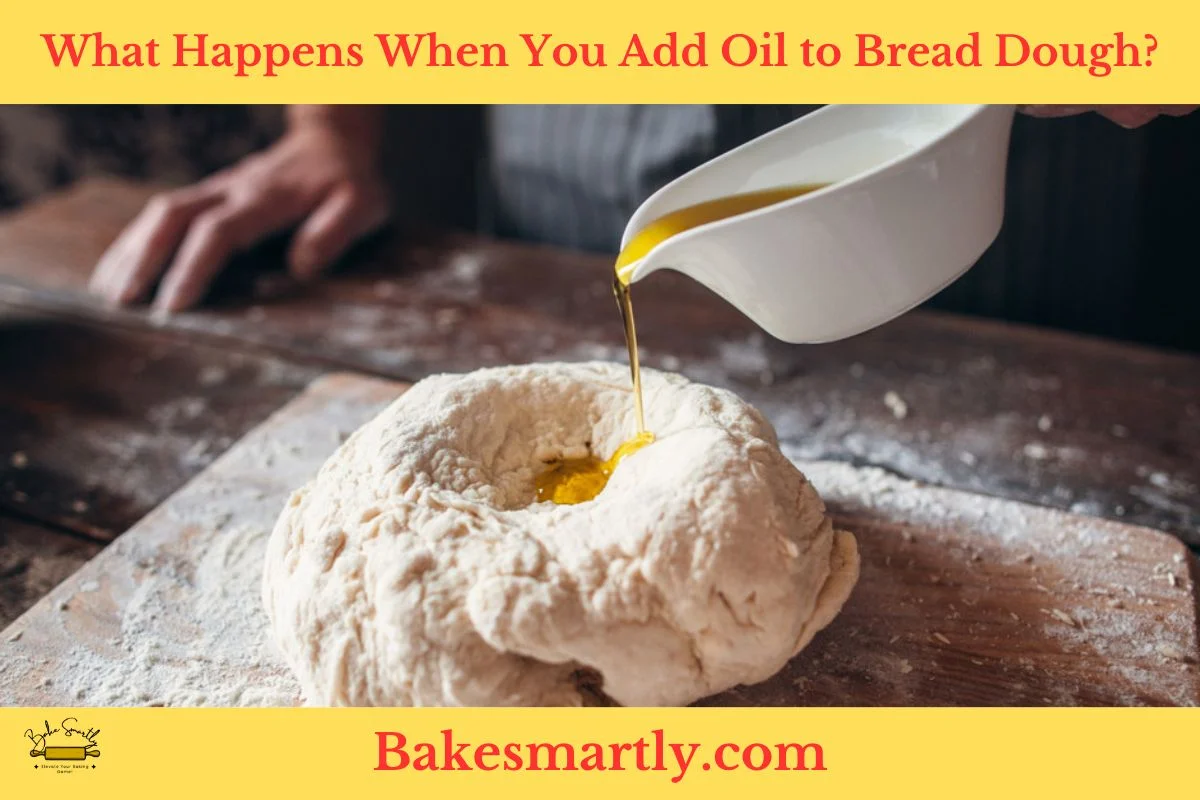
What Happens When You Add Oil to Bread Dough?
Baking bread is an age-old tradition that brings warmth and comfort to our homes. Whether you’re a seasoned baker or a novice, you’ve probably wondered about the role of oil in bread dough.
In this article, we’ll delve into the fascinating world of bread-making and explore the question: what happens when you add oil to bread dough? Let’s knead our way through this delicious journey.
Table of Contents
ToggleThe Role of Oil in Bread Dough
When we talk about bread, we often think of flour, water, yeast, and salt as the core ingredients. But oil is a lesser-known yet essential component in many bread recipes. Here’s what happens when you incorporate oil into your bread dough:
Enhancing Texture and Moisture
Oil plays a multifaceted role in bread-making, and one of its primary functions is enhancing the texture and moisture content of the final product. When oil is introduced into the dough, it acts as a source of fat.
This fat, in turn, contributes to the tenderization of the dough, resulting in a softer and more indulgent crumb texture in the finished bread. The moisture retained by the fat also ensures that your bread stays fresh and delectable for an extended period.
Extending Shelf Life
Oil in bread dough isn’t just about enhancing the momentary pleasure of consumption; it also extends the shelf life of your bread. The presence of fat slows down the staling process, which is when bread becomes dry and less palatable. Consequently, your homemade bread remains a delectable treat even days after baking.

What does oil do to a bread dough?
When it comes to creating the perfect bread, achieving the right texture and moisture levels is an art in itself. In this section, we’ll explore how oil works its magic, resulting in a soft and tender crumb while effectively managing dough hydration.
Soft and Tender Crumb
One of the most noticeable effects of incorporating oil into bread dough is the creation of a soft and tender crumb. This desirable texture is the result of the fat content in the oil. As the dough is kneaded and baked, this fat disperses evenly throughout, coating the gluten strands.
This coating acts as a barrier, preventing the proteins in the flour from forming an excessively strong gluten network. As a result, the bread’s crumb becomes softer, less chewy, and more delicate.
Managing Dough Hydration
Dough hydration is a critical aspect of bread-making, and oil plays a pivotal role in this regard. Hydration refers to the ratio of water to flour in your dough. The addition of oil not only contributes moisture but also helps in managing dough hydration levels.
By providing an additional source of liquid, oil ensures that the dough maintains its pliability, making it easier to work with during shaping and forming.
The Science Behind Moisture
To truly understand the science behind moisture in bread dough, it’s essential to recognize that water is both a friend and a potential adversary to bread bakers. While water is necessary for activating yeast and promoting gluten development, excessive moisture can lead to overly sticky and unmanageable dough.
Here, oil acts as a moisture regulator, striking the perfect balance. It prevents the dough from becoming too dry while also inhibiting excessive moisture absorption.

Using Oil Varieties in Bread Dough
Different oils bring distinct flavors, textures, and characteristics to your bread, and understanding how to handle various oil varieties is essential for crafting the perfect loaf. In this section, we’ll explore some common oil choices and their unique attributes.
Olive Oil: A Mediterranean Classic
Olive oil, often celebrated as the “liquid gold” of the Mediterranean, is a cherished choice for bread-making. Its fruity and slightly peppery flavor can add a delightful depth to your bread’s taste profile.
Extra virgin olive oil, in particular, is esteemed not only for its flavor but also for its rich antioxidant content, which can impart some health benefits to your homemade bread. When using olive oil, opt for a good-quality extra virgin variety to enjoy the fullest flavor potential.
Vegetable Oil: Versatile and Neutral
Vegetable oils like canola, sunflower, or safflower oil are prized for their versatility and neutral flavor profile. These oils serve as an excellent canvas for a wide range of bread types, allowing other ingredients to shine.
Their mild taste ensures that they won’t overpower the bread’s inherent flavors, making them a reliable choice for those who prefer a less pronounced oil presence in their loaves.
Specialty Oils and Their Uses
Beyond the classic olive and vegetable oils, the world of bread-making offers a myriad of specialty oils, each with its unique charm. Nut oils, such as walnut or hazelnut oil, bring a delightful nutty richness to your bread, perfect for adding complexity to artisanal loaves.
Sesame oil infuses a distinct, exotic flavor, making it an excellent choice for unique, globally-inspired bread creations. Coconut oil, with its tropical aroma, can lend a sweet, tropical twist to your baked goods.

Does Oil Affect Dough Rising?
The process of bread-making is a delicate dance of ingredients and techniques, where each element plays a crucial role. One question that often arises in the minds of bakers is whether the inclusion of oil in the dough affects its rising ability.
Let’s explore this aspect to better understand how oil interacts with the dough during the rising process.
In short, yes, oil can indeed impact dough rising, but the extent of its influence depends on several factors. Here’s a closer look:
- Amount of Oil: The quantity of oil you incorporate into your bread dough can determine the degree to which it affects the rising process. In small to moderate amounts, oil tends to have a minimal impact on the dough’s ability to rise. However, excessive amounts of oil can potentially hinder rising because the fat in the oil can coat the yeast cells, slowing down their activity. Therefore, it’s crucial to strike a balance when adding oil, ensuring that it complements the dough without impeding its rise.
- Type of Oil: Different oils have varying effects on dough rising. Neutral oils like vegetable oil or canola oil are less likely to interfere with yeast activity compared to oils with stronger flavors like olive oil or nut oils. While the latter can still be used successfully in bread-making, bakers often adjust their recipes to accommodate these flavor-rich oils.
- Mixing and Incorporation: Properly mixing and incorporating the oil into the dough is essential to mitigate any potential issues with rising. Ensuring that the oil is evenly distributed throughout the dough allows for consistent yeast activation and fermentation, promoting optimal rising.
How Much Oil Should I Use?
Determining the right amount of oil for your bread recipe is essential for achieving the desired texture and flavor. While the precise quantity varies depending on the specific recipe, a general guideline is to start with 2-3 tablespoons of oil for a standard loaf of bread.
However, it’s crucial to consult your recipe instructions, as they will provide the most accurate measurement. Keep in mind that the type of oil you choose, whether olive oil, vegetable oil, or another variety, can also influence the flavor and moisture retention of your bread. Experimentation can help you find the perfect balance to suit your taste preferences.
Common Mistakes and Troubleshooting
Bread-making, although a rewarding endeavor, can sometimes present challenges, especially when it comes to using oil in your dough. Let’s explore some common mistakes and effective troubleshooting techniques to ensure your bread turns out perfectly every time.
Avoiding Oily Residues
One common issue when adding oil to bread dough is the risk of ending up with an overly oily residue. This can happen if you use too much oil or if you don’t incorporate it evenly. To avoid this, ensure you measure your oil accurately according to your recipe’s specifications.
Additionally, make sure to evenly distribute the oil throughout the dough during the kneading process. Properly integrated oil should result in a moist, tender crumb without an unpleasant greasy feel.
Overcoming Sticky Dough
Sticky dough can be a baker’s nightmare, and excess oil is often the culprit. If your dough is too sticky, resist the urge to add more flour immediately. Instead, try incorporating extra flour gradually, a tablespoon at a time, until the dough becomes manageable.
Alternatively, you can oil your hands and work surface to prevent excessive sticking. Finding the right balance between oil and flour will help you achieve the ideal dough consistency.
When Too Much Oil Is Too Much
While oil enhances the texture and flavor of bread, excessive oil can lead to undesirable results. If you’ve accidentally added too much oil to your dough, don’t fret. You can remedy this situation by increasing the other ingredients proportionally.
This means adding more flour, water, yeast, and salt to balance the oil content. Keep adjusting until you reach the desired dough consistency.
Conclusion
Incorporating oil into your bread dough is a simple yet effective way to enhance the flavor, texture, and shelf life of your homemade bread. Whether you opt for olive oil, vegetable oil, or specialty oil, you’ll be delighted by the results. So, next time you embark on a bread-making adventure, don’t forget to add a touch of oil to your dough. Your taste buds will thank you for it!
Lindsey Mackenzie
About me
Hi there! I’m Lindsey Mackenzie, the founder of Bake Smartly. Baking has been my passion since childhood, growing up in my father’s bakery. With Bake Smartly, I’m excited to share my love for all things sweet and savory. Join me on this delicious journey as we whip up scrumptious treats and sprinkle joy into every bite!






